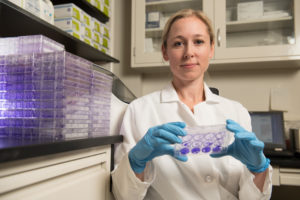
On July 17, Colorado State University received an award worth up to $9.5 million to develop a human vaccine against the Rift Valley Fever virus. John Wyckoff, the university’s principal investigator for the project, which is funded by the Coalition for Epidemic Preparedness Innovations (CEPI), spoke with SOURCE recently about what it means for CSU and global health.
Wyckoff is the director of the Biopharmaceutical Manufacturing and Academic Resource Center (BioMARC), a nonprofit contract development and manufacturing operation owned and operated by CSU to produce vaccines, therapeutics, diagnostics and other biopharmaceutical products. BioMARC is part of the Infectious Disease Research Center administered through the Office of the Vice President for Research at CSU, headed by Alan Rudolph.
How did CSU decide to take on this vaccine development project?
At BioMARC, we help biotech companies, large pharmaceutical companies and government agencies develop products that require specialized biological containment. BioMARC’s function is to serve as a stepping stone between discovery and development. Our team helps generate vaccine or diagnostic material that goes into preclinical studies in the lab. We also work toward manufacturing material for clinical studies, when products are tested in people.
CEPI had a call for proposals early this year. When that call came out, it was a great fit for what BioMARC does. Around 10 years ago, when I was working at Merial, a global animal health company, I was aware of this particular vaccine candidate, which is also why this project was appealing to me. A ‘vaccine candidate’ means that it has promise to be safe and to be effective, but it has not yet been approved by a regulatory agency for use in people.
How long have you been interested in infectious disease research and how did that start?

I’m an immunologist who has been focusing on development of vaccines against infectious diseases for animals and people my entire career. I had one professor in graduate school who not only was able to identify a fascination or ‘hot button’ I had for immunology, but he also stomped on it regularly, which challenged me, in a good way.
It remains a fact to this day that vaccination is the most cost-effective avenue for reducing infectious diseases that we know. It doesn’t matter whether you’re talking about animals that are raised for food, pets, or people.
Who are the partners CSU will be working with on this project?
BioMARC is leading this research project, and we have about 20 people involved at our facilities. We are also working with two faculty members at CSU who have both experience and interest in Rift Valley Fever virus: Assistant Professor Rebekah Kading and Professor Dick Bowen. They are both in the College of Veterinary Medicine and Biomedical Sciences and were natural additions to the team.
The vaccine that we will be testing was developed by the Viral Special Pathogens group at the Centers for Disease Control and Prevention. Stuart Nichol — who was the head of that group — and Brian Bird — also one of the inventors who is now at University of California, Davis — are also part of the project team at this point. There will be several phases to this project, and new partners to announce moving forward.
How would you describe CSU’s expertise in infectious disease research?

CSU has a long-standing international reputation of excellence for work in mycobacterial diseases, in particular tuberculosis. We have a lot of scientists who have really strong reputations in the infectious diseases research realm, not only in veterinary medicine but also in zoonotic diseases – ones that cross between humans and animals, like Rift Valley Fever – and vector-borne diseases – those that are transmitted by mosquitoes and ticks as well as other arthropods.
What should people know about Rift Valley Fever virus?
We do not yet have Rift Valley Fever in the United States. However, the virus is endemic throughout sub-Saharan Africa, and outbreaks usually occur in pastoral communities in lower-income countries. These rural communities have reduced access to public health services and their livelihoods are often closely linked to their livestock, which also happen to be a main amplifier for the Rift Valley Fever virus and exposure risk for people.
There is an urgent need to develop a vaccine for humans to mitigate this emerging epidemic threat, protect these vulnerable communities, and strengthen global health security in the process.
Rift Valley Fever is a fairly mild disease in most people. It causes a flu-like illness and most people recover in a week or two. However, there are a couple of serious forms of RVF infection, in particular one known as a hemorrhagic form, where the fatality rate can be as high as 50 percent.
For most cases of Rift Valley Fever, the overall fatality rate is about 1 to 2 percent.
In the United States, we do actually have mosquitoes that are capable of transmitting RVF virus, mostly through the Aedes and Culex species, as well as a few other species. There are similar species also found in continental Europe, so there is a risk of Rift Valley Fever spreading to other countries outside of sub-Saharan Africa.
Over the last 20 years, the virus has expanded in its reach. In the last 10 years, it has moved into the Arabian Peninsula, northeast of Africa, and Madagascar. In 2019, the island of Mayotte, which is northwest of Madagascar, has an ongoing outbreak of Rift Valley Fever among people and livestock.
Why are zoonotic diseases particularly worrisome in terms of public health?
Zoonotic diseases are particularly worrisome because most of our livestock enterprises in the U.S. are intense, meaning that we have large numbers of highly-susceptible animals confined in close proximity. You couldn’t ask for a better situation for a pathogen to come in, sweep through a barn full of broiler chickens, egg-producing hens, swine, or dairy cattle or feedlots for beef cattle. Diseases can potentially just sweep through situations like this.
If it’s a zoonotic disease, the people who take care of the animals can be at risk, and vice versa.
What draws you to work with vaccines? And is there a difference working in a university or industry setting?
Starting in graduate school, my interest was in immunology, and the big accomplishment of immunology that has done the most good is vaccine development. As I advanced in my career, I saw that in academia, to get a product developed and into the field where it did something good, was exceptionally difficult and time-consuming.
In industry, everything is about generating products. BioMARC is very much like a small company embedded in the university. I would describe us as 5 percent academic and 95 percent company-oriented, and that’s pretty unique.
That’s how I can give back to society, to develop things that benefit society in a large way.